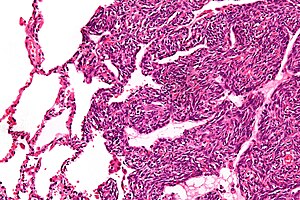Synovial sarcoma
| Synovial sarcoma | |
|---|---|
 |
|
| Micrograph of a monophasic synovial sarcoma. The histologic appearance is non-specific and overlaps with MPNST and fibrosarcoma. H&E stain. | |
| Classification and external resources | |
| ICD-10 | C49.9 |
| ICD-O | M9040/3-9043/3 |
| OMIM | 300813 |
| DiseasesDB | 34577 |
| MeSH | D013584 |
A synovial sarcoma (also known as: malignant synovioma) is a rare form of cancer which occurs primarily in the extremities of the arms or legs, often in close proximity to joint capsules and tendon sheaths. As one of the soft tissue sarcomas, it is one of the rarest forms of soft tissue cancer.
The name "synovial sarcoma" was coined early in the 20th century, as some researchers thought that the microscopic similarity of some tumors to synovium, and its propensity to arise adjacent to joints, indicated a synovial origin; however, the actual cells from which the tumor develops are unknown and not necessarily synovial.
Primary synovial sarcomas are most common in the soft tissue near the large joints of the arm and leg but have been documented in most human tissues and organs, including the brain, prostate, and heart.
Synovial sarcoma occurs most commonly in the young, representing about 8% of all soft tissue sarcomas but about 15–20% of cases occur in adolescents and young adults. The peak of incidence is in the third decade of life, with males being affected more often than females (ratio around 1.2:1).
Two cell types can be seen microscopically in synovial sarcoma. One fibrous type, known as a spindle or sarcomatous cell, is relatively small and uniform, and found in sheets. The other is epithelial in appearance. Classical synovial sarcoma has a biphasic appearance with both types present. Synovial sarcoma can also appear to be poorly differentiated or to be monophasic fibrous, consisting only of sheets of spindle cells. Some authorities state that, extremely rarely, there can be a monophasic epithelial form which causes difficulty in differential diagnosis. Depending on the site, there is similarity to biphenotypic sinonasal sarcoma, although the genetic findings are distinctive.
Like other soft tissue sarcomas, there is no universal grading system for reporting histopathology results. In Europe, the Trojani or French system is gaining in popularity while the NCI grading system is more common in the United States. The Trojani system scores the sample, depending on tumour differentiation, mitotic index, and tumour necrosis, between 0 and 6 and then converts this into a grade of between 1 and 3, with 1 representing a less aggressive tumour. The NCI system is also a three-grade one, but takes a number of other factors into account.
...
Wikipedia
